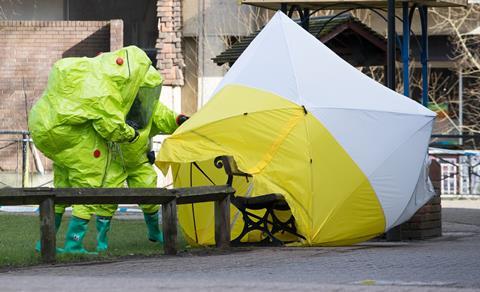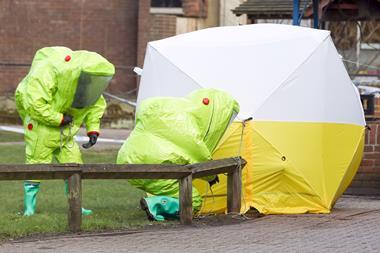
The nerve agent used in an attack on Sergei and Yulia Skripal was part of the Novichok family, the British government has revealed. This group of nerve agents was developed in Russia as part of a secret chemical weapons programme codenamed ‘Foliant’ in the 1970s and 80s.
Novichok – ‘newcomer’ in Russian – agents have never been used in warfare and publicly available information about them is limited. They were designed to evade detection by Nato’s standard chemical detectors and to defeat protective clothing, as well as being safer to handle. They are binary agents – meaning they are formed by mixing two relatively benign precursor chemicals just before use, which makes them safer to transport, store and handle.
Early information about Novichok compounds came from two whistleblowers, Lev Fedorov and Vil Mirzayanov, who were both chemists working at a secret military lab in Moscow. They published an article detailing ongoing chemical weapon experiments just before Russia signed the Chemical Weapons Convention in the early 1990s.
Russian authorities effectively admitted the existence of Novichoks when they brought a treason case against Mirzayanov for disclosing state secrets. Mirzayanov, who now lives in the US, has said hundreds of Novichok agents and derivative compounds were developed during the Foliant programme research. The exact identity of the agent used in the Salisbury attack has not been disclosed.
Lethal weapons
Nerve agents are exceptionally deadly. Exposure to a tiny dose, whether through skin contact, inhalation or ingestion, can quickly kill. Tens of milligrams of potent nerve agents such as VX have been known to prove fatal. Nerve agents’ killing power comes from their ability to shut down the body’s nervous system. Normally, electrical impulses travel along nerves taking messages around the body. As electrical impulses can only travel so far on a single neuron, organisms have developed a means of relaying messages from one neuron to another. When an impulse reaches the end of the line in a neuron it results in the release of a chemical neurotransmitter. This neurotransmitter signals to the next neuron that it should fire and send the message on.
A very common neurotransmitter is acetylcholine. This chemical not only ensures that neurons can pass electrical impulses on to other neurons, but is also responsible for signalling to muscles that they need to contract. Once acetylcholine has been released and the message passed along, it needs to be mopped up to prevent neurons firing continuously and muscles contracting constantly. The enzyme acetylcholinesterase is responsible for breaking down the neurotransmitter, hydrolysing it into acetate and choline. It is this enzyme that nerve agents attack. Organophosphorus compounds such as nerve agents bind to a serine amino acid in the enzyme’s active site, stopping it breaking down acetylcholine. As the acetylcholine builds up the victim can suffer from convulsions, paralysis and respiratory arrest that can cause death.
The bond that forms between the nerve agent and the enzyme can be broken by giving oxime drugs such as pralidoxime. This regeneration of the enzyme means it can function again as normal. However, the bond between the nerve agent and acetylcholinesterase can age – this is where a side group off the agent’s phosphorus gets hydrolysed. This strengthens the bond between the nerve agent and the enzyme, meaning that oxime drugs can no longer regenerate the enzyme. Ageing takes around five hours with sarin and 40 hours with VX. Novichok agents are thought to have a comparable chemical structure to other nerve agents, so it is quite possible they act in a similar manner but it is unknown whether the bond between these agents and its target enzyme ages quickly, slowly or not at all.
Shadowy compounds
A compendium of chemical warfare agents written in 2007 by chemist Steven L Hoenig says Novichok agents may be up to 10 times stronger than VX.
They are organophosphorus compounds, Hoenig writes, and he puts forward some proposed structures for some Novichoks – such as novichok-5, novichok-7 and novichok-# – that were derived from what he calls ‘A-series’ nerve agents. He cautions that most of the information provided is an ‘educated guess’.
The compounds are thought to be made by reacting a substituted 2-methyl-1,3,2-dioxaphospholane (depending on which Novichok is being made) with dichlorofluoro(nitroso)methane. Neither of these precursors are controlled by the Chemical Weapons Convention, which would have allowed Russia to circumvent a ban on manufacturing chemical weapons.
Confused picture
Alternative structures have been put forward for novichok agents, however – including by Mirzayanov in his 2009 autobiography – and there is confusion even among chemical weapons experts.

‘It’s all a little unclear,’ says Alastair Hay, a professor of environmental toxicology at the University of Leeds, UK, who has investigated alleged uses of chemical weapons in the field. ‘They’re organophosphates and appear to operate in the same way as other organophosphates. The treatment protocols are similar, though the oxime you use to try and pull a nerve agent off the critical enzyme [it binds to] may be different.’
Scientists at Porton Down would have been able to identify the agent, he adds, because the laboratory has been assembling information on potential threats for decades. ‘What they will have done is made these chemicals, suspecting they were part of the Soviet or Russian arsenal,’ Hay says. Then chemists at Porton Down would have ’assessed their structure and put them into a library of reference materials’, he adds.

Information on Novichoks indicates that the agent used in the Salisbury attack could have been administered as a powder, spray or gas, although no information has been provided so far.
Public Health England has said that there is little risk to the public at large. Nerve agents degrade on contact with water, and the area of Salisbury where the attack took place has been hosed down. People who visited the same restaurant and pub as the Skripals on the day of the attack have been advised to wash their clothing to eliminate any risk of long term exposure.
Both victims are still being treated in hospital and remain in a critical condition.
Additional reporting by Patrick Walter












1 Reader's comment